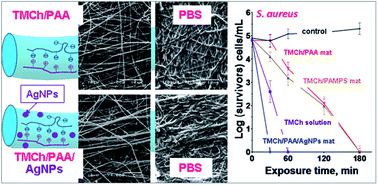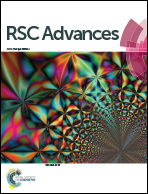Novel antibacterial electrospun materials based on polyelectrolyte complexes of a quaternized chitosan derivative†
Abstract
Novel nanofibrous materials composed of polyelectrolyte complexes (PECs) between N,N,N-trimethylchitosan iodide (TMCh) and poly(acrylic acid) (PAA) or poly(2-acrylamido-2-methylpropanesulfonic acid) (PAMPS) were prepared. This was achieved by facile one-pot electrospinning of solutions of the oppositely charged polyelectrolyte partners. It was rendered possible by using a solvent system containing formic acid and/or by adding a strongly ionized low-molecular-weight salt (CaCl2). Use of formic acid enabled TMCh/PAA nanofibers containing in situ synthesized silver nanoparticles (AgNPs) to be electrospun. The AgNPs had an average diameter of 3.0 ± 0.8 nm and were uniformly distributed in the nanofibers as evidenced by the performed transmission electron microscopic (TEM) analyses. The prepared nanofibers preserved their morphology and did not dissolve in phosphate-buffered saline (PBS). Hybrid AgNPs-containing PEC nanofibrous materials showed good antibacterial activity against Gram-positive bacteria Staphylococcus aureus and Gram-negative bacteria Escherichia coli and possessed higher efficacy than that of the nanofibers of the same composition without AgNPs and TMCh.


 Please wait while we load your content...
Please wait while we load your content...